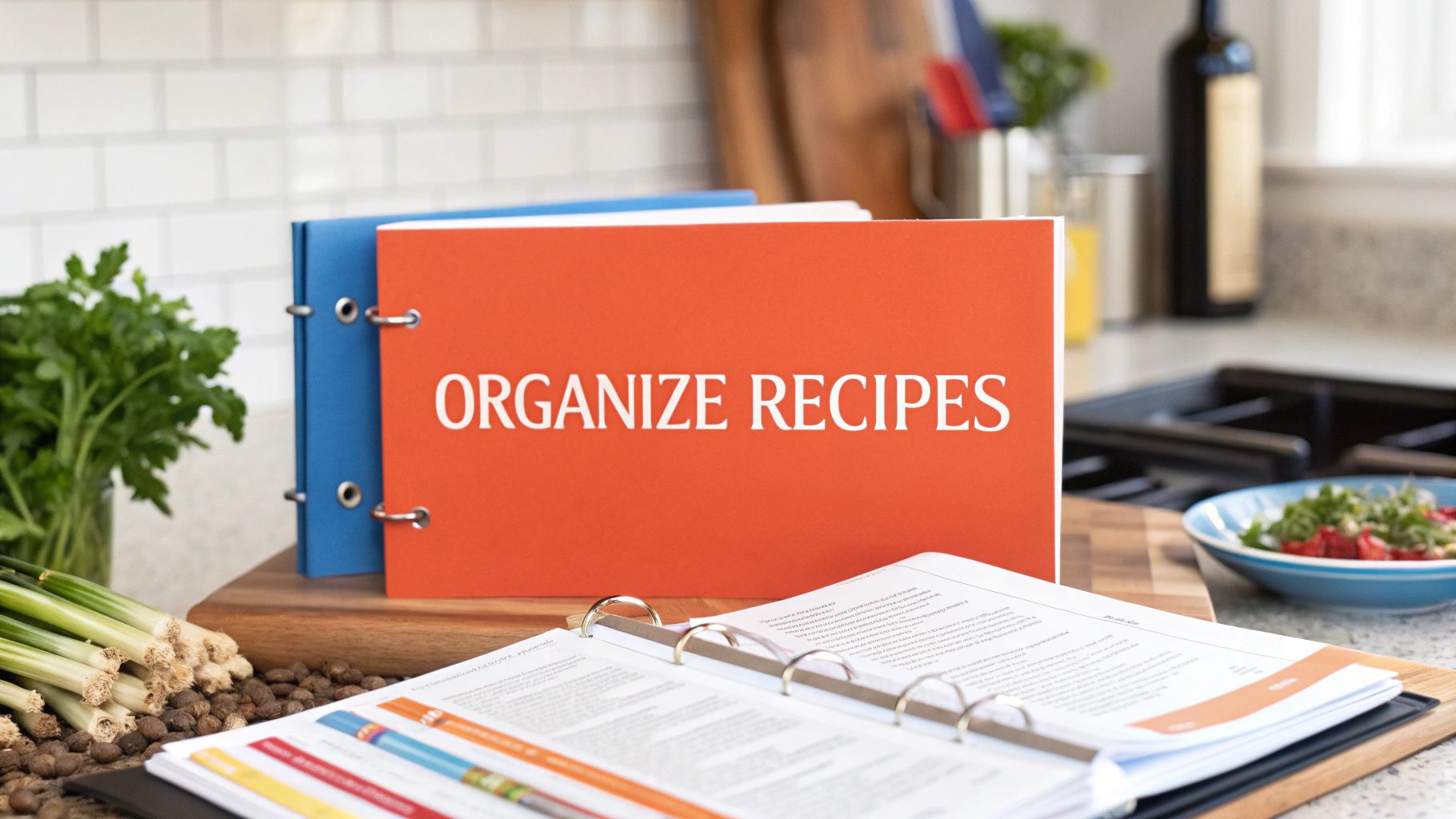Why Your Recipe Collection Deserves Better Organization
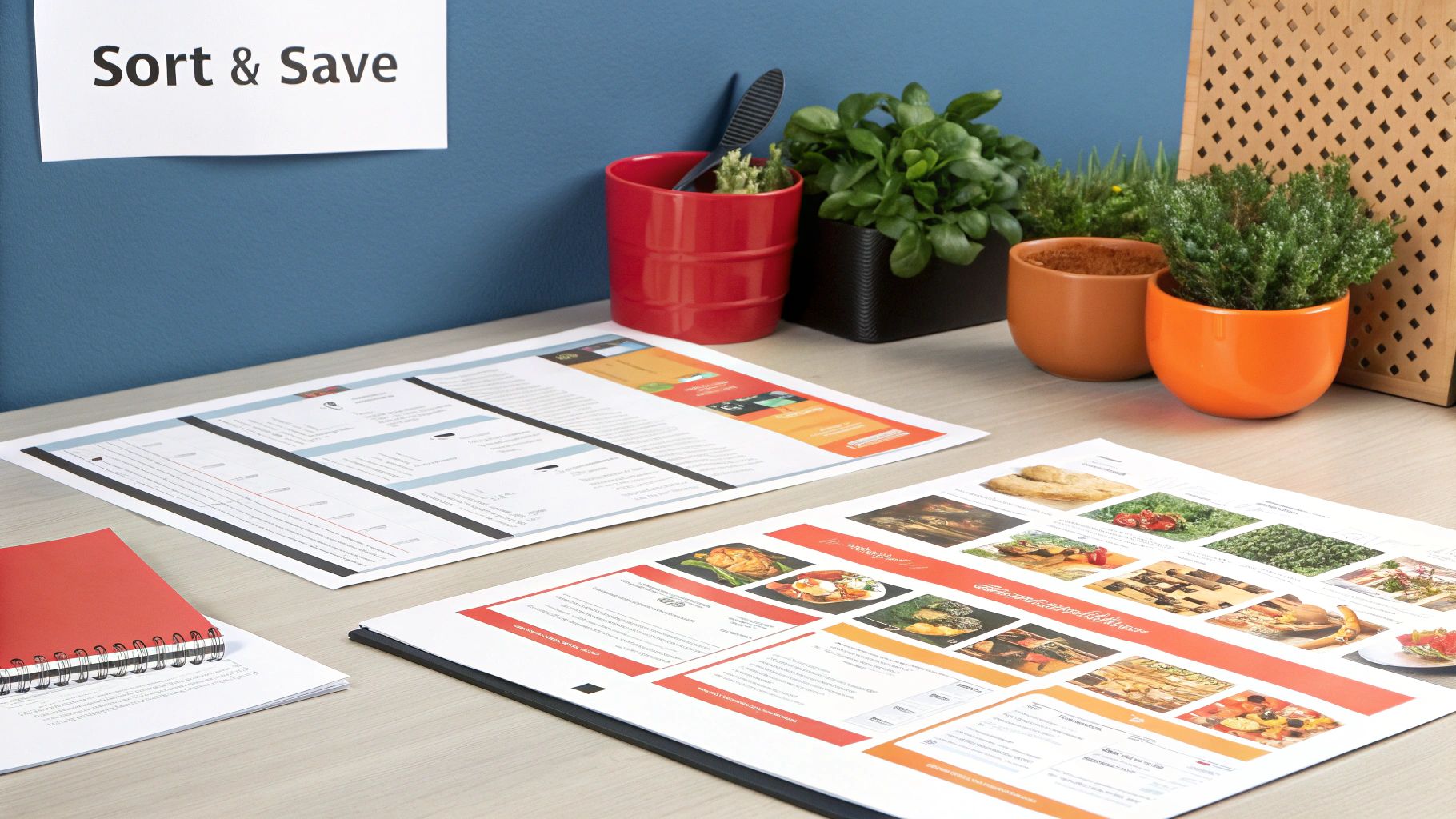
Let's be honest, that overflowing recipe drawer or box is a common sight. It’s a jumble of clippings, handwritten notes, and torn magazine pages. It's a constant reminder of that organization project we keep putting off. Transforming this chaos into an organized system can dramatically improve your cooking experience.
This isn't about aesthetics; it's about rediscovering the joy of cooking.
Imagine effortlessly finding the perfect weeknight dinner recipe. No more rummaging through a pile of papers! Think about preserving cherished family recipes. Ensure they're passed down through generations. Proper organization unlocks these benefits and more.
The Emotional and Practical Benefits of Organization
Organizing your printed recipes isn't just practical; it's self-care for your culinary life. It streamlines meal planning and reduces cooking stress. It can even inspire culinary creativity. This means less time searching and more time savoring.
An organized system provides easy access to treasured family recipes. Keep those culinary traditions alive!
Historically, even recipe formats have evolved for better organization. In the 19th century, recipes transitioned from narrative-style text to the separated ingredient and method format we use today. This shift, pioneered by figures like Eliza Acton and Isabella Beeton, laid the groundwork for modern recipe organization. Learn more about this fascinating history: The Evolution of Recipe Writing Style.
From Chaos to Culinary Library: Real-Life Transformations
Many home cooks have experienced the power of recipe organization. Stories abound of people going from frantic recipe hunts to curated collections. They report significant time savings in meal planning and renewed enthusiasm for cooking. One home cook compared it to going from a chaotic closet to a well-stocked library.
This improved accessibility leads to rediscovering forgotten favorites. Recipes once buried in clutter are brought back into rotation. This adds variety and excitement to mealtimes. Organizing your printed recipes isn't a chore; it's an investment. It's an investment in a more enjoyable and fulfilling cooking experience. This leads us to exploring different organization methods, which we'll cover in the next section.
Taking Inventory: What's Actually in Your Collection
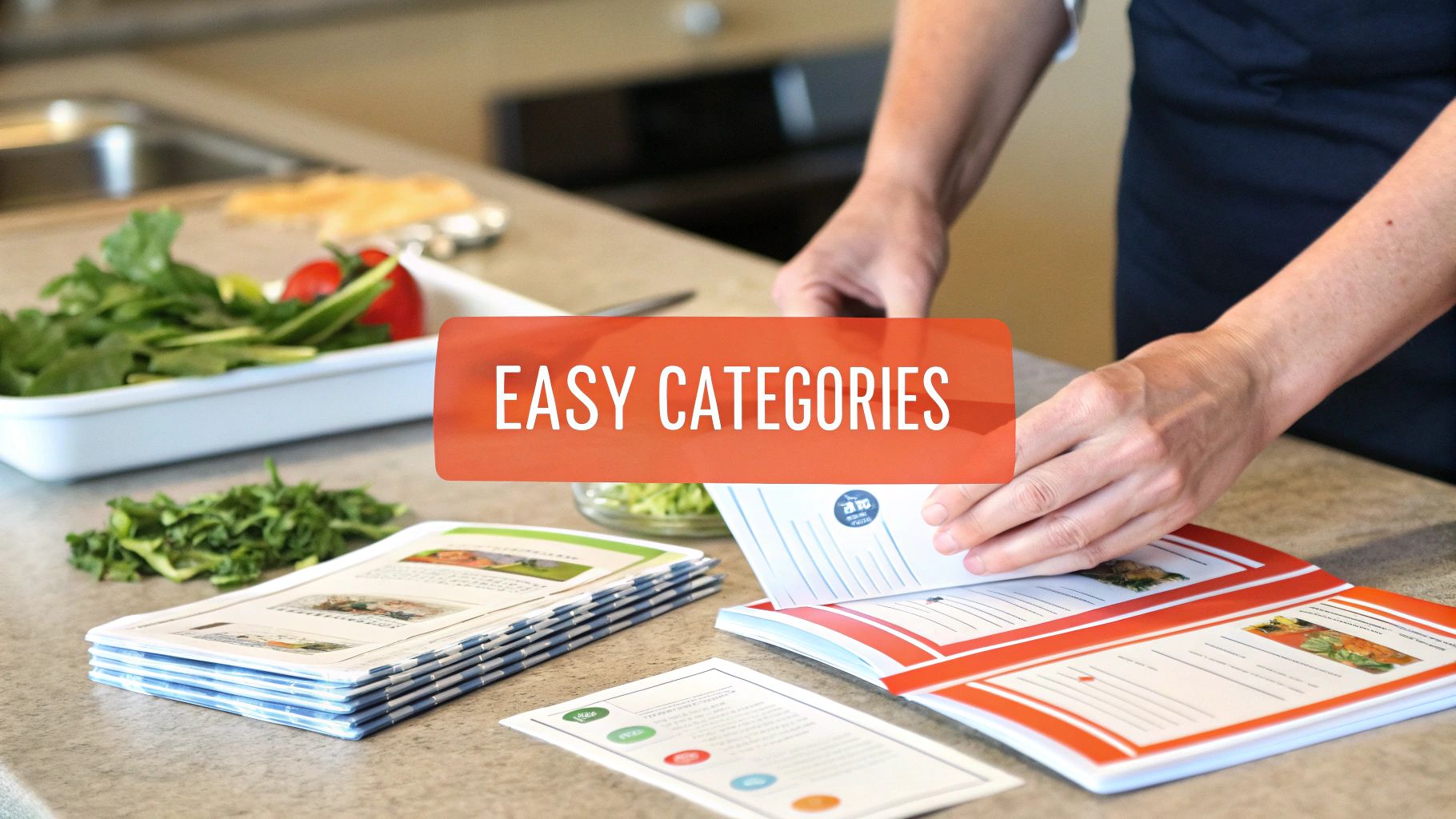
Before diving into organizing your printed recipes, take a moment to assess your collection. This crucial first step prevents you from feeling overwhelmed and lays the groundwork for a smooth organization process. It's not just about counting; it's about understanding the value and how you use each recipe.
The Four-Step Sorting Process
Professional organizers often use a four-step process for decluttering and assessing any collection. Adapting this for recipes provides a helpful structure for deciding what to keep and what to discard.
-
Gather: Bring together every single recipe. This includes those tucked away in cookbooks, magazines, and even scraps of paper. Seeing the total volume helps you grasp the scope of your collection.
-
Sort: Divide your recipes into broad categories like "Main Courses," "Desserts," "Family Recipes," or "Recipes to Try." This initial sorting reveals patterns and helps you see what you have.
-
Purge: Be honest about which recipes you actually use. Discard duplicates, variations you don't prefer, and recipes you’re unlikely to ever make. This step streamlines your collection.
-
Categorize: Refine your initial categories into more specific groups. "Main Courses" could become "Chicken," "Beef," "Vegetarian," etc. This detailed categorization prepares you for effective organization.
Handling Different Recipe Formats
Printed recipes come in various forms, from delicate vintage cards to magazine tear-outs. Each format requires a slightly different approach during the inventory stage.
-
Recipe Cards: Check their condition. If they're brittle or faded, consider digitizing or reinforcing them to prevent further damage.
-
Magazine Clippings: Ensure they're complete and easy to read. Gluing them to cardstock or placing them in sheet protectors adds durability.
-
Cookbook Recipes: List the cookbook titles and the recipes you use frequently. This helps determine if you need the entire cookbook or just copies of specific recipes.
Consider the historical aspect of recipes. Early handwritten recipe books, while not standardized like modern ones, offer a unique perspective. For example, Mistress Anna Campbell's Her Paistrie Booke (1707) contains 400 recipes in loose categories, reflecting the personal nature of these collections. Learn more about historical recipe practices.
Digitizing vs. Physical: Making the Right Choice
Some cooks prefer a fully digital approach, while others enjoy the tactile experience of printed recipes. The key is finding what works for you. Digitizing provides a backup for irreplaceable family recipes. However, for everyday use, physical copies are often more convenient in the kitchen.
This inventory process is a solid starting point for organizing printed recipes effectively. By understanding your collection, you can choose storage and categorization systems that meet your needs.
Storage Systems That Actually Work in Real Kitchens
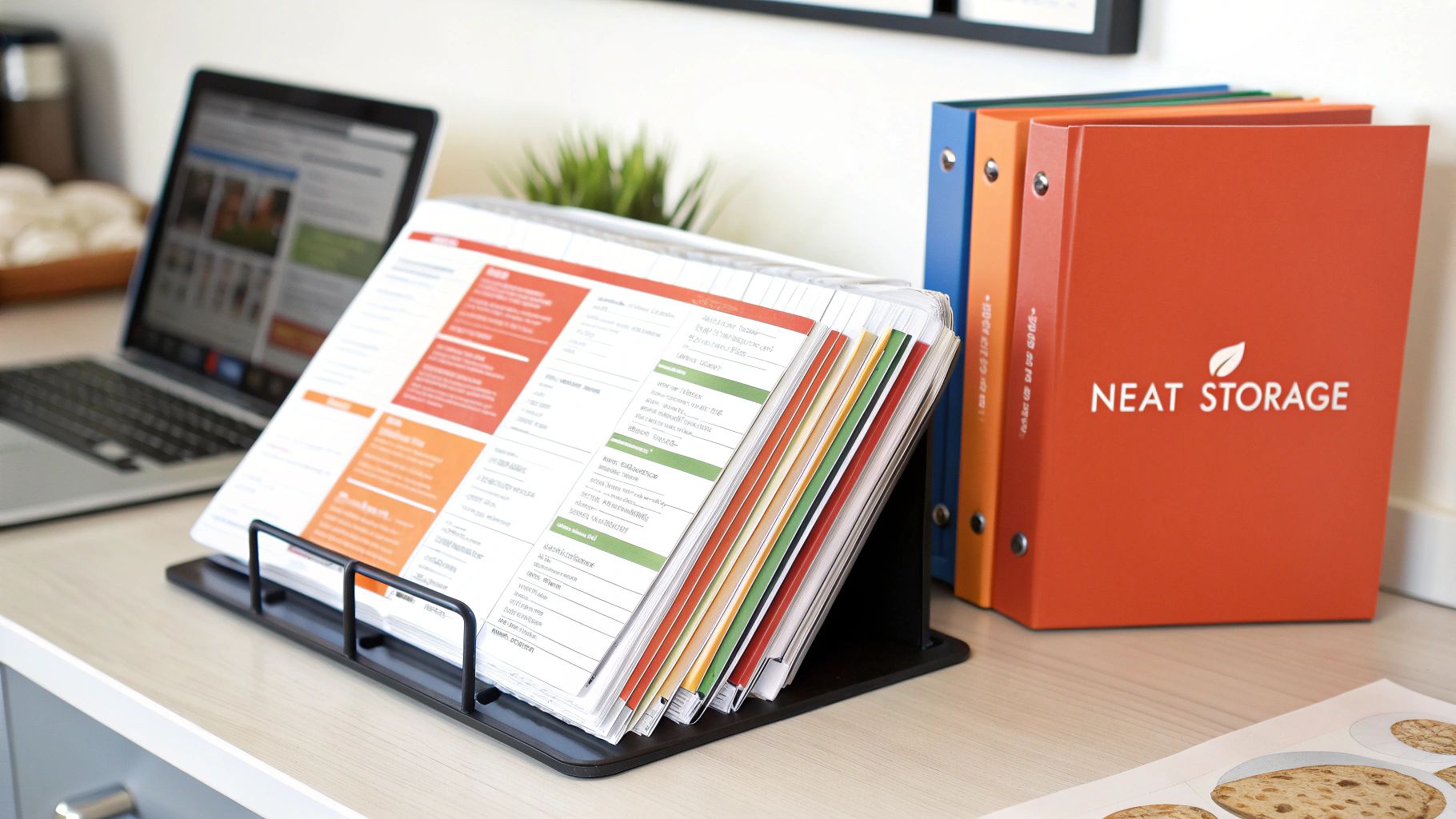
Now that you’ve inventoried your recipes, let's talk storage. We’re skipping the picture-perfect-but-impractical Pinterest boards and focusing on real-world kitchen solutions. These methods are tried and true, used by everyone from busy weeknight cooks to serious chefs.
The Binder System: Customizable and Adaptable
Binders are a great way to personalize your recipe organization. From handwritten cards to magazine clippings, binders can hold it all, especially with the help of protective plastic sleeves. This flexibility makes them perfect for diverse recipe collections.
- Pros: Customizable, affordable, easy to expand, and durable.
- Cons: Can get bulky and require regular decluttering to prevent overflow.
The Recipe Box: Classic and Compact
The classic recipe box remains a favorite for good reason. Its compact size is perfect for small kitchens or storing your most-used recipes. Many also come with dividers for basic categories, making it easy to get started.
- Pros: Space-saving, classic charm, easy to find in stores, often includes dividers.
- Cons: Limited capacity, hard to expand, and not ideal for oversized recipes.
DIY Solutions: Repurposing and Personalizing
Thinking beyond traditional storage opens a world of possibilities. Repurposing items like photo albums or index card files creates unique, budget-friendly solutions. This lets you tailor the system to your exact needs and style.
- Pros: Budget-friendly, highly personalized, uses what you already have, and encourages creativity.
- Cons: Requires more initial setup, and maintaining a consistent organizational method is key.
To help you choose, here’s a table comparing the different options:
Recipe Organization Systems Comparison
| Organization System | Best For | Cost Range | Space Required | Ease of Use | Expandability |
|---|---|---|---|---|---|
| Binder System | Diverse collections, various recipe formats | Low | Moderate (can become bulky) | Easy | High |
| Recipe Box | Smaller kitchens, frequently used recipes | Low | Low | Easy | Low |
| DIY Solutions (e.g., Photo Albums, Index Card Files) | Personalized systems, utilizing existing resources | Very Low | Variable, depends on repurposed item | Moderate | Variable |
This table highlights the strengths and weaknesses of each system, allowing for a quick comparison based on your individual needs. While binders offer maximum flexibility, recipe boxes are best for a curated selection. DIY solutions offer a personalized approach but demand consistent organization.
Maintaining Your System: The Key to Long-Term Success
The best system is the one you’ll actually use. Whether you choose a binder, a box, or a DIY method, staying organized is crucial. Simple habits, like filing new recipes right away, make a big difference. For managing digital recipes, check out this helpful resource: How to master your digital recipe collection with an app.
Choosing the Right System for You
Consider your cooking style and kitchen space. Visual cooks might prefer a binder with pictures, while methodical cooks might like the structure of a recipe box. The goal is to find a system that fits your personality and how you work in the kitchen. A good storage system makes finding recipes easier and cooking more enjoyable. By choosing the right system for you, organizing recipes becomes less of a chore and more of a key ingredient in your culinary journey.
Beyond Meal Types: Categorization That Makes Sense
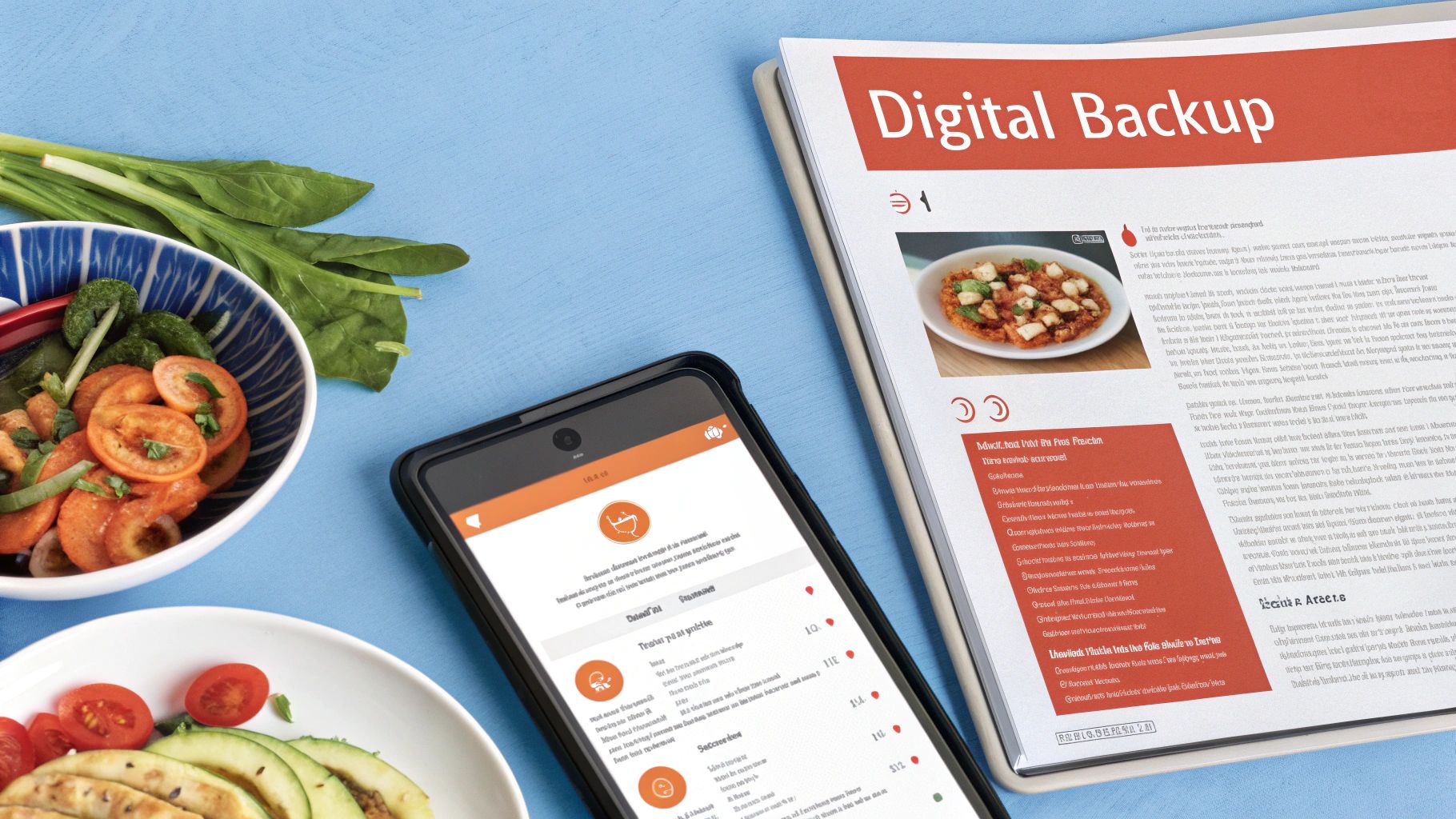
Standard "breakfast, lunch, and dinner" categories often fall short. They don't reflect how we actually use recipes. This section explores more practical ways to categorize your printed recipes. This includes organizing by ingredients, occasions, and even cooking methods, making your collection truly work for you.
Ingredient-Focused Organization: Cooking With What You Have
Think about how you actually decide what to cook. Often, it’s based on what’s already in your fridge. Organizing recipes by key ingredients—"Chicken," "Beef," "Beans," etc.—makes this process much smoother. You might be interested in: How to categorize recipes effectively.
For example, if you have leftover chicken, you can quickly flip to the "Chicken" section in your binder and find a new recipe. This ingredient-first approach simplifies meal planning and reduces food waste.
Occasion-Based Organization: Streamlining Special Events
Another helpful approach is organizing by occasion. "Weeknight Meals," "Holiday Dishes," or "Party Food" categories make planning for specific events easier. This is especially useful for frequent entertainers or those with recurring family meals.
Imagine a dedicated section for quick weeknight dinners. This eliminates the scramble for inspiration after a long day. Having occasion-based categories streamlines meal preparation and reduces stress.
Hybrid Systems: Combining the Best of Both Worlds
Many cooks find success combining various methods. This hybrid approach provides maximum flexibility. One popular method is the "core plus satellite" system.
This keeps frequently used recipes easily accessible while maintaining a larger, categorized collection. This blended approach allows cooks to tailor their organization to their specific needs.
Cross-Referencing: Finding That "Chicken Dish With Apples"
Effective organization goes beyond simple categories. Implementing a cross-referencing system, like adding keywords or tags, ensures you can find specific dishes, even if you forget their names. This is helpful for those "I know I have a recipe for…" moments.
You can use sticky notes, tags, or a separate index to link related recipes across categories. Cross-referencing adds another layer of searchability to your recipe collection.
Personalized Categorization: Tailoring to Your Needs
The most effective system is tailored to your cooking habits. A parent with picky eaters might categorize by "Kid-Friendly Meals," while someone with dietary restrictions might organize by "Gluten-Free" or "Vegan" recipes.
Statistically, cookbook organization can have a broad impact. If a cookbook sells 10,000 copies and is used by four people each, that's 40,000 individuals. If 75% report improved cooking skills, that's 30,000 people. Find more detailed statistics here: Statistics and Data Analysis. This personalized approach makes your recipe collection truly work for you. By adapting your organization, you create a practical and sustainable system. This lets you enjoy the benefits of organization without feeling constrained.
Creating a Digital Backup Without Abandoning Paper
The classic debate of paper versus digital recipes misses a crucial point: the best solution often involves both. This section explores building a hybrid system. Keep the tactile joy of your printed collection while enjoying the ease of digital access. This approach gives you the best of both worlds.
Digitizing Your Treasured Recipes
Making digital backups of your irreplaceable recipes doesn't have to involve countless hours of scanning. Several efficient methods make the process easier:
- Smartphone Apps: Many apps are specifically designed for recipe capture. They offer features like image straightening and Optical Character Recognition (OCR) , making digitization quick and easy, even in a busy kitchen.
- Photography: A simple photo with your smartphone can effectively capture a recipe. Make sure you have good lighting and a clear image for readability.
These methods let you create digital copies of your favorite recipes quickly. This preserves your culinary heritage without needing a full digital conversion.
Linking Your Physical and Digital Worlds
Clever techniques can seamlessly connect your physical and digital recipe collections:
- QR Codes: Create QR codes that link to online recipe versions or your personal notes. Attach these codes to recipe cards or binder pages for quick digital access.
- Cloud Storage: Services like Google Drive or Dropbox can store digital copies and photos, providing a secure backup you can access from anywhere.
These methods create a dynamic link between your physical and digital systems. You can easily see extra information, variations, or personal notes related to a specific printed recipe. This offers a richer experience than a paper-only system.
Technology has greatly influenced how we organize recipes. Digital platforms make recipes easily searchable, categorized, and shareable. This has resulted in online recipe databases and cooking apps with extensive filtering options. For example, an app with 100,000 recipes and 20 filter categories provides a vast, organized collection tailored to specific needs. Learn more about this evolution: The History of Cookbooks.
To help you explore different options for managing printed recipes digitally, here's a helpful table:
Digital Tools for Printed Recipe Management
Overview of apps and software that can help manage and enhance printed recipe collections
| Tool Name | Primary Function | Compatibility with Printed Recipes | Learning Curve | Cost | Notable Features |
|---|---|---|---|---|---|
| Recipe Apps (e.g., Paprika, ReciMe) | Recipe organization, meal planning | Can import photos of printed recipes, some with OCR | Varies by app | Typically a one-time purchase or subscription | Searchable database, grocery lists, cross-device syncing |
| Scanning Apps (e.g., Adobe Scan, Microsoft Lens) | Document scanning and digitization | Specifically designed for scanning documents, including recipes | Easy to use | Often free, with optional premium features | OCR, cloud storage integration, image enhancement |
| Cloud Storage (e.g., Google Drive, Dropbox) | File storage and backup | Can store photos and digital copies of recipes | Easy to use | Free and paid plans depending on storage needs | Secure backup, accessibility from multiple devices, sharing options |
| Note-Taking Apps (e.g., Evernote, OneNote) | Note organization and storage | Can create digital notes linked to photos of printed recipes | Easy to moderate | Free and paid plans depending on features | Tagging, searching, web clipping |
| Spreadsheet Software (e.g., Google Sheets, Microsoft Excel) | Data organization and analysis | Can create custom databases of printed recipes | Moderate | Often included with office software suites or available through subscriptions | Customizable fields, sorting and filtering, formula functions |
This table summarizes several tools available for managing your printed recipes digitally. Each tool offers different features and levels of compatibility, so consider your specific needs when choosing the best one for you.
Learning From Others: Real-World Experiences
Many cooks have integrated digital tools with their printed recipe collections. Some prefer dedicated recipe management software, while others prefer simpler methods like smartphone photos. The key is to choose methods that simplify your cooking, not complicate it. Explore more tips in our guide on digital recipe organization.
This hybrid approach blends the best of physical and digital organization. You keep the sentimental value and simplicity of printed recipes while gaining the searchability and backup security of a digital system. This creates a truly personalized and efficient way to manage your treasured recipes.
Protecting Your Culinary Heritage
Protecting your recipes ensures they'll be around for years to come. Digital backups offer security against damage or loss to your physical collection. A hybrid approach safeguards both your original documents and digital copies, preserving your culinary heritage. This gives you peace of mind knowing your recipes are safe and sound.
Building Habits That Keep Your Collection Organized
An organized recipe collection isn't a final goal; it's an ongoing process. The organizational systems you choose are only as effective as the habits you build to maintain them. This section focuses on developing sustainable practices to keep your collection useful and current. This involves incorporating simple, efficient routines into your everyday cooking.
The Two-Minute Rule: Preventing Backlog Buildup
One of the biggest hurdles in maintaining any organizational system is avoiding backlog. Think of it like your email inbox: if you don't manage it regularly, it quickly becomes overwhelming. The two-minute rule, a concept from time management techniques, provides a straightforward solution: if filing a new recipe takes less than two minutes, do it immediately.
This prevents small tasks from accumulating into a much larger, more daunting project. For instance, after trying a new dish, file the recipe right away in your designated binder or box. This quick action preserves order and saves you future headaches.
Seasonal Review Rituals: Keeping Your Collection Relevant
Our tastes and cooking habits change over time. A seasonal review helps align your recipe collection with your current preferences. Schedule some time each season to browse your recipes. Discard or archive dishes you no longer enjoy, or those that no longer fit your lifestyle. This might involve storing summer barbecue recipes once autumn arrives.
This easy practice ensures your collection remains a practical tool, not a repository of forgotten meals. It also creates room for new recipes and keeps your system in sync with your evolving culinary tastes.
Integrating Annotations and Modifications: Embracing the Evolution of a Recipe
Recipes are rarely set in stone. We often tweak them based on our tastes, available ingredients, or feedback from family and friends. Incorporating these adjustments into your system requires a plan. Consider a consistent approach, such as writing directly on recipe printouts (protected by sheet protectors) or using sticky notes.
This allows your collection to truly reflect your personal cooking style. For instance, jotting down that you swapped honey for sugar in a cookie recipe creates a customized version for the future. Your collection evolves with you, becoming a unique chronicle of your culinary journey.
Shared Collections: Getting the Family Involved
For many, a recipe collection is a shared family treasure. Involving family members in the upkeep of the system is vital for its continued success. This could mean assigning responsibilities like filing new recipes or clipping recipes from magazines.
Sharing the responsibility lightens the burden and encourages a sense of shared ownership. It also creates a space for everyone to contribute to the family’s food history, building a living archive of cherished meals and traditions.
Recovering From Neglect: Getting Back on Track
Even the most meticulously maintained systems can suffer from periods of neglect. Life happens. Don't feel guilty about it. Instead, see it as a chance to revitalize and improve your system.
Begin with a quick sort, concentrating on organizing your most frequently used recipes. Then, gradually work your way through the remaining backlog. This method helps you regain control without feeling overwhelmed. It also underscores the importance of regular upkeep, making future neglect less likely.
Building lasting habits requires time and effort. Start with small steps, focus on consistency, and tailor these strategies to your personal cooking routine. By embracing these practices, your organized recipe collection will become a treasured resource, enriching your cooking experiences for years to come.
Ready to elevate your recipe organization? Recify, a recipe management app, offers a seamless way to save and organize recipes from anywhere online. Transform your device into a personalized cookbook and eliminate scattered screenshots and lost links. Learn more about Recify and start your free trial!
